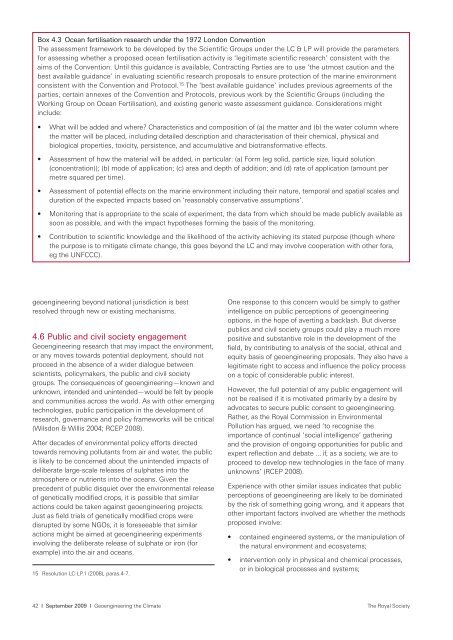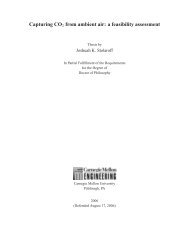Royal Society - David Keith
Royal Society - David Keith
Royal Society - David Keith
You also want an ePaper? Increase the reach of your titles
YUMPU automatically turns print PDFs into web optimized ePapers that Google loves.
Box 4.3 Ocean fertilisation research under the 1972 London Convention<br />
The assessment framework to be developed by the Scientific Groups under the LC & LP will provide the parameters<br />
for assessing whether a proposed ocean fertilisation activity is ‘legitimate scientific research’ consistent with the<br />
aims of the Convention. Until this guidance is available, Contracting Parties are to use ‘the utmost caution and the<br />
best available guidance’ in evaluating scientific research proposals to ensure protection of the marine environment<br />
consistent with the Convention and Protocol. 15 The ‘best available guidance’ includes previous agreements of the<br />
parties, certain annexes of the Convention and Protocols, previous work by the Scientific Groups (including the<br />
Working Group on Ocean Fertilisation), and existing generic waste assessment guidance. Considerations might<br />
include:<br />
• What will be added and where? Characteristics and composition of (a) the matter and (b) the water column where<br />
the matter will be placed, including detailed description and characterisation of their chemical, physical and<br />
biological properties, toxicity, persistence, and accumulative and biotransformative effects.<br />
• Assessment of how the material will be added, in particular: (a) Form (eg solid, particle size, liquid solution<br />
(concentration)); (b) mode of application; (c) area and depth of addition; and (d) rate of application (amount per<br />
metre squared per time).<br />
• Assessment of potential effects on the marine environment including their nature, temporal and spatial scales and<br />
duration of the expected impacts based on ‘reasonably conservative assumptions’.<br />
• Monitoring that is appropriate to the scale of experiment, the data from which should be made publicly available as<br />
soon as possible, and with the impact hypotheses forming the basis of the monitoring.<br />
• Contribution to scientific knowledge and the likelihood of the activity achieving its stated purpose (though where<br />
the purpose is to mitigate climate change, this goes beyond the LC and may involve cooperation with other fora,<br />
eg the UNFCCC).<br />
geoengineering beyond national jurisdiction is best<br />
resolved through new or existing mechanisms.<br />
4.6 Public and civil society engagement15<br />
Geoengineering research that may impact the environment,<br />
or any moves towards potential deployment, should not<br />
proceed in the absence of a wider dialogue between<br />
scientists, policymakers, the public and civil society<br />
groups. The consequences of geoengineering—known and<br />
unknown, intended and unintended—would be felt by people<br />
and communities across the world. As with other emerging<br />
technologies, public participation in the development of<br />
research, governance and policy frameworks will be critical<br />
(Wilsdon & Willis 2004; RCEP 2008).<br />
After decades of environmental policy efforts directed<br />
towards removing pollutants from air and water, the public<br />
is likely to be concerned about the unintended impacts of<br />
deliberate large-scale releases of sulphates into the<br />
atmosphere or nutrients into the oceans. Given the<br />
precedent of public disquiet over the environmental release<br />
of genetically modified crops, it is possible that similar<br />
actions could be taken against geoengineering projects.<br />
Just as field trials of genetically modified crops were<br />
disrupted by some NGOs, it is foreseeable that similar<br />
actions might be aimed at geoengineering experiments<br />
involving the deliberate release of sulphate or iron (for<br />
example) into the air and oceans.<br />
15 Resolution LC-LP.1 (2008), paras.4-7.<br />
One response to this concern would be simply to gather<br />
intelligence on public perceptions of geoengineering<br />
options, in the hope of averting a backlash. But diverse<br />
publics and civil society groups could play a much more<br />
positive and substantive role in the development of the<br />
field, by contributing to analysis of the social, ethical and<br />
equity basis of geoengineering proposals. They also have a<br />
legitimate right to access and influence the policy process<br />
on a topic of considerable public interest.<br />
However, the full potential of any public engagement will<br />
not be realised if it is motivated primarily by a desire by<br />
advocates to secure public consent to geoengineering.<br />
Rather, as the <strong>Royal</strong> Commission in Environmental<br />
Pollution has argued, we need ‘to recognise the<br />
importance of continual ‘social intelligence’ gathering<br />
and the provision of ongoing opportunities for public and<br />
expert reflection and debate ... if, as a society, we are to<br />
proceed to develop new technologies in the face of many<br />
unknowns’ (RCEP 2008).<br />
Experience with other similar issues indicates that public<br />
perceptions of geoengineering are likely to be dominated<br />
by the risk of something going wrong, and it appears that<br />
other important factors involved are whether the methods<br />
proposed involve:<br />
• contained engineered systems, or the manipulation of<br />
the natural environment and ecosystems;<br />
• intervention only in physical and chemical processes,<br />
or in biological processes and systems;<br />
42 I September 2009 I Geoengineering the Climate The <strong>Royal</strong> <strong>Society</strong>








